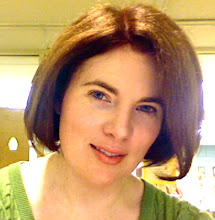Professional Resource - Merchandising Made Simple by Jenny LaPerriere and Trish Christiansen
Having crunched most of the data from my spring Recreational Reading survey of my Upper School students (based on the Carol Fitzgerald article I blogged about in the fall), I have a lot of data from kids on how the library could better market to them. The overwhelming consensus from the free responses is that kids want to be advertised and marketed to - there were so many poster/e-newsletter/flyer suggestions from kids that this is undoubtedly what we need to focus on. Enter a fabulous book every librarian should read, Merchandising Made Simple: Using Standards and Dynamite Displays to Boost Circulation
Enter a fabulous book every librarian should read, Merchandising Made Simple: Using Standards and Dynamite Displays to Boost CirculationMerchandising, by its very definition, means displaying your product in a way that makes consumers want to "buy it" and take it home with them. You are creating a need that your customer maybe didn't know they had. Luckily for librarians, our product is so terrific that we can feel extremely enthusiastic about marketing to our patrons, particularly when the cost is something already covered by their taxes or, in my case, by their tuition.
So why do librarians break out in hives when we are encouraged to emulate the bookstore model? When I renovated my library a couple years ago, the students from my Library Advisory Board who met with the architect and interior designer described their ideal library this way, "If an Apple store and Barnes & Noble had a baby, that's we want our library to look like." Clean lines, modern, technology, but comfortable seating and books were all priorities in these visionary students' minds. I think you can see from the above picture that our space is extremely well used and it's all of those things (there are comfy armchairs along the sides of the space which aren't really visible in this photo, trust me). I'm not planning on abandoning the Dewey Decimal system (just because I feel my students are 99% college bound and need to learn to navigate a classification system so they feel comfortable in a college library - I like to delude myself that most of them do know there are print books you should read in addition to my terrific databases.)
The book is now my primer for marketing (combined with my survey results) and I plan on having this be a staff meeting right when school starts. We were in the process of doing a fiction weed and the face out space will be valuable real estate for promoting the collection, but I have so many other ideas from this book. Themed displays (the final chapter has some really terrific ideas and I want to try at least half of them) are obviously great, but the authors give direction in terms of getting inexpensive props, how to do an effective tiered display, how to use signage as a draw, etc. I had no idea of the "crescent" concept (think of a traditional stack and having the face outs on each shelf form a backwards C from top to bottom) and I also didn't know that when customers enter a space they naturally pull to the right, so that's where many stores have key displays when they want to push a product.
There are tons of pictures (which probably is why the reading time is so minimal with this book) but the content is information rich, and there are chapter bibliographies for further reading and a list of questions to ask yourself (or your staff) to see if you fully market your collection. Two pieces I'm taking to heart (after the themed ideas which I think is great) - to use a calendar (in my case, not just the usual holidays but also coinciding with known extracurriculars like International Food Night or research projects) and also to have a display map, so all staff know what endcaps and windowsills have got which type of books on them.

 Two other books which I haven't read but also seem like they would have great information are Great Displays for Your Library Step by Step
Two other books which I haven't read but also seem like they would have great information are Great Displays for Your Library Step by Step


































1 comments:
Write commentsThese books sounds great! I'll have to put them on my reading list :)
Reply